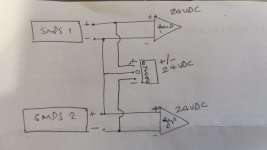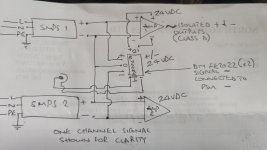You probably want to add the signal grounds and outputs in that picture...?
//
//
... yeah most definitely... unless you check the power supplies first. The DC out negative (minus) must not be DC coupled to the mains earth...Can I do this without releasing any magic smoke?
Half of me says yes, the other half tells me 'interesting' things will happen.
For example, the 24V / 5A MeanWell brick sold at the DiyAudio Store must not be used... unless you lift the ground connection off the 24V DC out negative (minus):
Note: use a couple of disk ceramic caps with short legs to AC couple the 24V DC out negative to ground (mains earth)... 10nF and 100nF in parallel should do.
There might also be an issue with the loads on each of the two shown amplifiers. If these are driving speakers for instance, the two speaker - terminals cannot be returned to the same ground.
Also, if the two signals into the two amps are coming referred to the same ground, it will probably not work.
The problem with the circuit schematic is that it does not show the load and signal connections; if you do that the plot (problems, really) will be much clearer.
Jan
Also, if the two signals into the two amps are coming referred to the same ground, it will probably not work.
The problem with the circuit schematic is that it does not show the load and signal connections; if you do that the plot (problems, really) will be much clearer.
Jan
Thanks guys. These PSU (LRS 150-24) have isolated DC from ground so the bipolar thing isn't an issue. Done it before with my M2X.
Amps are class D so the output 'negative' isn't a chassis ground.
I think I'll just use a separate bipolar PSU for the buffer!
Amps are class D so the output 'negative' isn't a chassis ground.
I think I'll just use a separate bipolar PSU for the buffer!
Last edited:
I don't understand the significance. Or are you saying the class D are balanced out?Amps are class D so the output 'negative' isn't a chassis ground.
At any rate, you need to feed signals into the class D. And one signal needs to be referenced to a different ground than the other because the two amps have different 'supply windows'. So if the two signals have a common ground like in a stereo pair, there could be a problem.
You really should draw the whole circuit including sources to get that clear.
Jan
I don't understand the significance. Or are you saying the class D are balanced out?
Here Jan you stated....
The class D doesn't use a common ground for speaker negative as far as I am aware so that was me trying to clarify that bit. The speaker output negatives aren't connected to ground.There might also be an issue with the loads on each of the two shown amplifiers. If these are driving speakers for instance, the two speaker - terminals cannot be returned to the same ground
That doesn't cover the input signal side granted so I'll look to draught a clearer scheme.
I'm getting out of my depth a bit here!.
A balanced output amplifier doesn't need a ground speaker wire. Some class D amps are balanced out, some are not.
This should be checked to be sure.
Jan
This should be checked to be sure.
That's why we're here for ;-)I'm getting out of my depth a bit here!.
Jan
- Home
- Amplifiers
- Power Supplies
- 2 x SMPS, use for 2 X single rails and 1 X bipolar?

